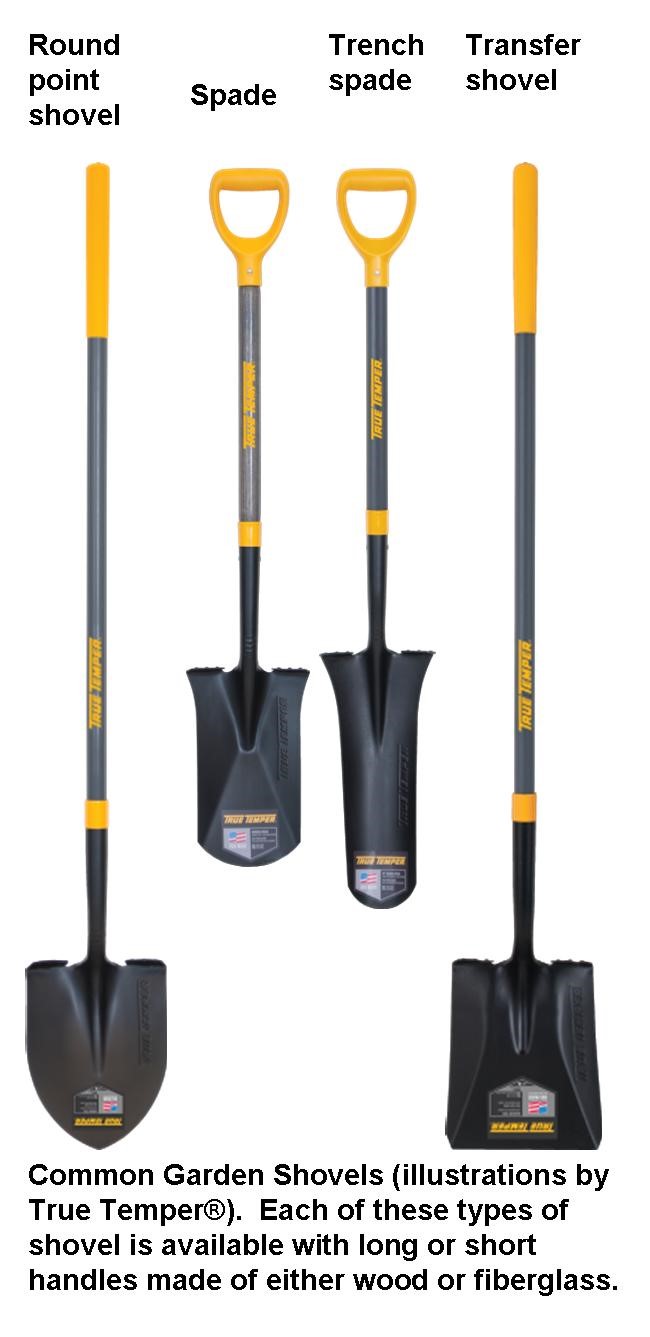Shovels 101

Shovels come in a variety of shapes and sizes, and you can pay as much as you like for a shovel. First of all, do you want a short handle or a long handle? According to True Temper®, short handles allow more precise digging in small spaces or in raised beds, while long handles are the standard, versatile choice and are especially useful when you need more leverage.
After you decide on a long or a short handle, should that handle be wood or fiberglass? The advantages of the fiberglass handle are that they are more durable than wood, do not shrink and become loose, and they do not crack. They can be left out in the weather and will not rot or get soaked and loosen when they dry. However, you get what you pay for, and a cheap fiberglass handle may be quite heavy, which means more work and perhaps joint pain as well as sore muscles. A quality fiberglass handle is equivalent in weight to a wood handle and has enough flexion to absorb some of the shock involved with digging, as wood does.
You can buy forged shovels and you can buy stamped shovels. “Forged” means cast from molten metal, while “stamped” means the shovel is made from a piece of flat sheet metal. The stamped variety are more common and are cheaper. However, a stamped shovel will provide a long service life if you take care of it, so the extra cost of a forged shovel may not be worthwhile (unless, perhaps, you are a professional shoveler). Whichever you buy, make sure there is a flat area on the back edge to step on when driving the shovel into the earth. You may wind up standing on that flat part and bouncing up and down to cut through turf or soil someday. I’ve done it.
Now you need to decide on which type of shovel to buy. Are you going to be digging a hole? Need to cut through turf or heavy clay soil? Moving mulch or gravel? Trenching for a pipe or cable? Here are descriptions of the most common shovel types used in gardening.
The most familiar shovel used for digging holes is the round point shovel. It has a somewhat curved blade viewed from above, because, after all, most holes are round. Next, the spade is used for hard packed soil and cutting through turf. A spade has a somewhat narrower blade with less curve. In fact, you can dig a square hole with a spade. The blade has a less pointed edge than the round point shovel, and the edge may even be square. Then we have the trenching spade, which is narrower and is ideal for digging a trench for a drain or an irrigation pipe. Finally, you might use a transfer shovel for moving gravel, compost, and loose dirt. It typically does not have a sharp edge because instead of digging, you’re scooping loose material. It has a wide, curved blade with a flat edge and can move a lot of material with each motion.
There are other types of shovels, mostly intended for special applications. Snow shovels and roofing removal shovels are examples. But the four discussed in this article are probably the most common shovels used in the home garden.
Care of shovels: Be careful using the handle of a shovel as a lever, because you can break the handle or bend the blade. This might happen when you cut into dense soils and try to pry out a clump of dirt. If the soil won’t move easily, try cutting into the earth in several adjacent spots to break it loose. A bent blade will soon split, and a broken handle ruins the shovel.
Shovels don’t require a lot of maintenance. After use, it is wise to wash off mud or debris because it has a tendency to hold moisture and cause rust. When shovels used for cutting into soil become dull, you can sharpen them a little with a file, or at least remove any ragged edges, but don’t go for a razor-sharp blade on a shovel.
